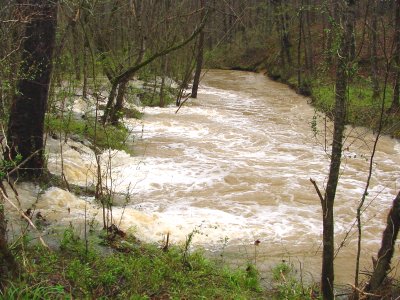Thursday, February 28th - - It was about 180 miles from Seminole Canyon State Park to the northern entrance of Big Bend National Park. At 10:30 when I finally left Seminole Canyon, the temperature was 57 degrees with a few clouds, lots of blue skies and sunshine.
Once you get to the entrance of Big Bend, it is another 30 miles to the visitor center at Panther Junction, then another 24 miles to the Rio Grande Village area in the eastern side of the park. The road to Rio Grande Village is mostly downhill - it takes you into the "lower" portion of the park - and the temperature went from a cool 60 degrees to a much warmer 69. Yeah, that was nice!
I picked out my campsite, which was to be "home" for the next four nights. The campground was not full by any means and there were plenty of sites to choose from whether you wanted one "out in the open" or more secluded along the southern section (as I did). As usual in most National Parks there are no hookups for electricity or water in the "main" campground. However, Big Bend does have an "RV" area with hookups but it is pretty much a parking lot.
Friday, March 1st - - It got quite cold during the night, as expected, and it sure would have been nice to have a little heater to take the chill out of the air. Instead, I just stayed in the sleeping bag a little longer than usual...
It was still chilly when I finally got up, but it was quite comfortable sitting in the sunshine and eating my breakfast. I decided to drive up to the Chisos Basin area, stopping along the way for some photos...

Looking to the West, from about 5 miles east of the Panther Junction visitors center.

Somewhere along the lower portion of the road to Chisos Basin. It's about 8 miles once you turn off the main road to Chisos Basin. The road goes uphill, winding its way through the mountains, gaining several thousand feet in elevation, and making several hairpin turns. The road is not recommended for vehicles pulling trailers longer than 20 feet or for RVs more than 24 feet long.

I don't think there have been any recent bear sightings, but mountain lions were seen in several areas earlier in February. One was even sighted along the Window View Trail not far from the visitors center and the Chisos Lodge.

Once you get to the highest point along the highway, you then start going down into the basin area. Hidden out of view are the campground and Chisos Mountain Lodge.

Traveling a little further along the road, the campground area comes into view. I stayed there for five nights on my visit in February ... The vehicles look so tiny compared to the mountains surrounding them.

The view through the "window" from the Window View Trail near the visitor center and Chisos Mountain Lodge.
My visit this year would be very different than it was in .., and shorter. My legs can't handle the long hikes as well as they did three years ago and I am pitifully out of shape. Nevertheless, the visit this year was very enjoyable and more relaxing, and of course, there will be more posts/photos to come. Below is a list of the posts from the .. visit I thought you might enjoy reading again (or perhaps, for the first time) - I was far more adventurous then!
- February 20, .. - Chisos Basin (posted March 10th)
- February 21, .. - Lost Mine Trail (posted March 11th)
- February 22, .. - Laguna Meadows Trail (posted March 12th)
- February 23, .. - Snow in the Chisos (posted March 13th)
- February 24, .. - The Window Trail (posted March 14th)
- February 25, .. - Rio Grande Village (posted March 15th)
- February 26, .. - Down by the River (posted March 16th)
- February 27, .. - Hot Springs Trail (posted March 17th)
- March 1 & 2, .. - Cerro Castellan (posted March 19th)
- March 1 & 2, .. - Castolon Homesteads (posted March 20th)
- March 1 & 2, .. - Santa Elena Canyon (posted March 21st)








 Pilots Richard Bovey, Bryan Campbell and Scott Salkovics from the 159th alpha Company Army Reserve, accompanied by two climbing rangers, spent four days at Mount Rainier training and climbing to the summit via the Emmons Winthrop Route. All three men have trained at Mount Rainier in high altitude rescue and provided critical support in Search and Rescue. In addition to their assistance with SARs, Bovey, Campbell and Salkovics are also huge supporters and fans of Mount Rainier. Bovey and Campbell have done volunteer work to help restore two of the lookout towers and all are avid outdoorsmen. Although they have all hiked in the Park extensively (Campbell completed the Wonderland Trail in a seven day period) none had summitted Mount Rainier.
Pilots Richard Bovey, Bryan Campbell and Scott Salkovics from the 159th alpha Company Army Reserve, accompanied by two climbing rangers, spent four days at Mount Rainier training and climbing to the summit via the Emmons Winthrop Route. All three men have trained at Mount Rainier in high altitude rescue and provided critical support in Search and Rescue. In addition to their assistance with SARs, Bovey, Campbell and Salkovics are also huge supporters and fans of Mount Rainier. Bovey and Campbell have done volunteer work to help restore two of the lookout towers and all are avid outdoorsmen. Although they have all hiked in the Park extensively (Campbell completed the Wonderland Trail in a seven day period) none had summitted Mount Rainier.
















